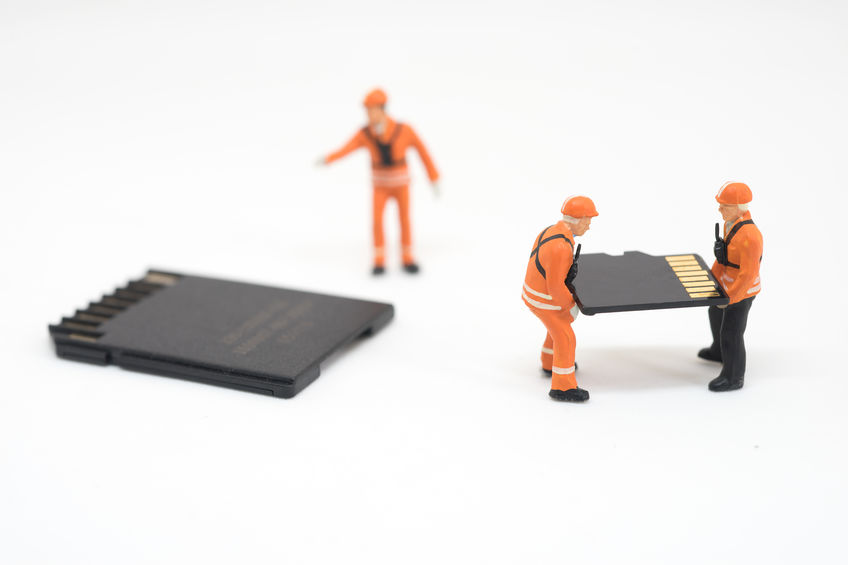DISCLOSURE: AS AN AMAZON ASSOCIATE I EARN FROM QUALIFYING PURCHASES. READ THE FULL DISCLOSURE FOR MORE INFO. ALL AFFILIATE LINKS ARE MARKED #ad
4K video is starting to become the standard resolution for digital cameras. Unfortunately, most of your existing SD cards may not work.
When you record footage, the camera stores frames on the SD card. If the camera cannot write to the card fast enough, it drops frames. The camera may even shut off or stop recording.
In other words, you need a fast and reliable card with enough capacity to shoot 4K video at high bit rates.
Here are my top recommendations, along with tips for comparing SD cards.
Table of Contents
1. SanDisk 128GB Extreme PRO
The SanDisk 128GB Extreme PRO offers excellent value due to its reasonable price and fast speeds.
It is a UHS-I SD card with a U3 speed rating and a V30 video speed class. The card is tested to provide write speeds up to 90MB/s with theoretical speeds up to 104MB/s.
It is not the fastest card available, but it offers reliable performance.
2. Lexar Professional 1667X SDXC Card
The Lexar Professional 1667X SDXC Card is a step from the SanDisk Extreme PRO.
Instead of UHS-I, this card uses UHS-II technology, which offers the potential for faster speeds. The Lexar SD card also boasts a higher video speed class.
The V60 rating provides stable write speeds of 60MB/s without dropping frames.
3. Sony M Series SDXC UHS-II Card
The Sony M Series UHS-II card is comparable to the Lexar Professional.
It has a V60 video class rating and a maximum write speed of 100MB/s. It is also available in 128GB and 256GB sizes.
Compared to the Lexar Professional SD card, the Sony M Series card is a little expensive but waterproof and guaranteed to work with Sony cameras.
4. Kingston SDXC Canvas React Plus Card
The Kingston Canvas React Plus SD card is a UHS-II with a V90 video speed class.
It meets all the requirements for optimal 4K shooting, including recording speeds up to 260MB/s. The only drawback is the price.
However, this is one of the few cards ready for 8K video. It also comes in 128GB and 256GB sizes.
5. SanDisk 128GB Extreme microSD UHS-I Memory Card
If the previous options are out of your price range, this microSD card from SanDisk provides the minimum speed needed for 4K video.
It is affordable in various sizes, from 32GB to 1TB.
When using a microSD card, you must use the SD adapter that comes with the card.
However, there is a risk that some cameras may not recognize the card.
This is more likely to occur if the card’s size exceeds the capacity accepted by the camera, requiring you to check your camera’s specs or if the connection in the adapter is damaged (see the part on failure rates further down in the guide).
What Speed SD Card Do I Need for 4K Video?
For optimal results, use an SD card with a theoretical write speed of 312MB/s and a rated speed of 30MB/s.
Standard cards include a “C” symbol to designate the speed class, while the high-end cards needed for 4K video also contain a “U” symbol. The “C” symbol stands for “class”.
There are four standard speed classes:
- Class 2: 2MB/s
- Class 4: 4MB/s
- Class 6: 6MB/s
- Class 10: 10MB/s
10MB/s is not fast enough for 4K video. A high-end 4K camera that shoots UHD video at 30 frames per second captures about 30 to 60 megabytes of data per second.
For the 4K video, you need SD cards that contain the “U” symbol. Faster SDXC cards have an ultra-high-speed (UHS) rating, including a number in the letter “U.”
There are three categories based on write speeds:
- U1: 10MB/s
- U2: 20MB/s
- U3: 30MB/s
A U3 speed class is the recommended choice for a 4K video. However, a couple more speed classes are to be considered, including the video speed class.
The video speed class is a value ranging from V6 to V90. V30 is considered the minimum recommended video speed class for 4K video.
The final detail related to the speed class is the theoretical speed of the UHS card. The latest generation of UHS cards provides the fastest theoretical speeds:
- UHS-I: Up to 104MB/s
- UHS-II: Up to 312MB/s
- UHS-III: Up to 624MB/s
Based on this information, you should look for a UHS-I or UHS-II SD card with a “U3” speed class and at least a “V30” video speed class for most 4K cameras.
What Speed Do You Need for the All-I 400Mbps Codec?
The All-I 400Mbps codec is intended for high-end editing. Every captured frame is stored as a keyframe, meaning each frame is treated as a separate image. This allows the camera to capture the highest resolution possible.
If you plan on using the All-I 400Mbps codec with a 4K camera, such as the Panasonic GH5, you need an SD card with the V60 or V90 video speed class rating.
V60 cards have a minimum write speed of 60MB/s, while V90 cards write at 90MB/s.
What Is the Failure Rate for SD Cards?

Manufacturers do not list failure rates. However, inferior components make cheap SD cards more likely to fail prematurely.
Each time you insert or remove an SD card, the friction creates wear on the contacts. After thousands of uses, the contact may not achieve a solid connection, resulting in disk failure.
Flash memory cards also have limited write cycles. However, the cards from top brands can be written up to 100,000 times.
If you want to decrease the risk of failure rates, only buy from trusted brands such as SanDisk, Lexar, and Kingston.
Conclusion
Look for an SD card that can support 4K video and the codec you plan on using for compression.
If you use the new All-I codec, you need a video speed class of at least V60, such as the Sony and Lexar cards. The Kingston card has a V90 rating but costs twice the price.
For other 4K video codecs, a video speed class of V30 should suffice, which includes the SanDisk cards.
If it has a V30 or higher rating, it should also meet the other requirements, such as a “U3” UHS class and “UHS-II” or “UHS-III” standards.
Just make sure that it offers enough storage. With a 128GB card, you may store a little over two hours of footage.
To become an expert on memory cards, look at the Ultimate Guide To Memory Cards And SSDs For Video Recording, where you can read about everything from SD-cards to CFast, SSDs, and more.







I like cameras that have built-in redundancy for file writing but I do not know a DSLR that writes dual card 4K video. I would rather trust my 4K shooting to a CF card even though they’re more expensive.
I think you’re right when it comes to 4K video and DSLRs in particular. But there are plenty of mirrorless camera options available that let you record 4K to two SD-cards simultaneously. Panasonic GH5 comes to mind.